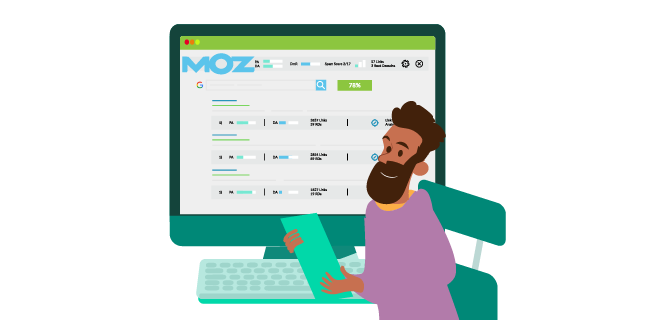Have you ever considered how your website stacks up against your competitors?
Not just in terms of its rankings and the content it has to offer. But how much traffic actually visits the sites and engages with its pages.
Checking website traffic isn’t just a “nice-to-have”, it’s an essential tool. Especially for anyone looking to be a market leader within their industry.
As the saying goes, ‘keep your friends close and your enemies closer.’ And that’s certainly true when it comes to your competition analysis.
Having insight into the amount of traffic a website has can help you assess the size of your competition. It can also help you plan your content strategy more efficiently. And make the most effective changes for prospective gains.
Without it, you won’t have a clear understanding of which brands your audience are most engaged with. Or which areas of your own site you need to improve in order to drive them to you. All of which are essential insights to help you rank higher and increase visibility of your brand online.
In this guide, we’re going to delve deeper into why you should be checking how much traffic a website receives. You’ll learn about the best online tools to help you compare your traffic against your competitors.
What is Website Traffic?
Website traffic refers to the number of people visiting a website at any one time.
On popular search engines like Google, website traffic is generally measured in ‘sessions.’ A session is counted when a user views one or multiple pages within an active time frame.
By default, a session lasts until there’s 30 minutes of inactivity. Or until the searcher closes their web browser or exits the site.
For example, let’s say a user named Betty lands on your website. As soon as Betty lands on your website, Google Analytics will start counting that ‘session.’
Whilst Betty is viewing your site, her neighbour Jill rings the doorbell. Betty goes to answer the door and engages in a 31-minute conversation with Jill. As a result, Betty’s session expires.
However, when Betty returns from her conversation, she continues to browse the same website. But because Betty was inactive for over 30 minutes, this then counts as a new session.
Sessions can be invaluable metrics for businesses looking to analyse their website’s performance. Specifically, because you can see where visitors are spending their time.
Why Should You Compare Your Website Traffic Against Your Competitors’ Site?
To ensure the success of any ongoing marketing strategy, you should be conducting a regular competition analysis against your most direct competitors.

If you want to be the market leader online, then reviewing the performance of your competitors’ websites is essential in winning the battle. Not only can it help to generate ideas for improving your own website. But you can also identify your competitors’ weak spots, and target that with quality content.
Analysis of your competitors’ website traffic can help you to understand which brands your target audience are interacting with. As well as measure what type of content is helping convert them into customers.
By benchmarking your website in this way, you can:
- Gain valuable insights about your brand online
- Identify potential opportunities for growth
- Refine your overall marketing strategy accordingly
Step by Step Guide: How to Check Your Competitors’ Website Traffic
Below, you’ll find a five easy-step guide to checking your competitors’ website traffic. Follow these steps carefully. As a result, you will have a clearer understanding of how your brand stacks up against those within your industry.
1. Identify Competitors
If you don’t already have an understanding of who your competitors are, then now is the time to research.
Discovering and identifying your closest competitors is extremely easy to do. And this can be done with one great and almighty tool: Google.
First, place yourself in ‘incognito’ mode. This is to avoid skewing your search results with the cookies in your own search history. Then, conduct a search about your product or service.

Don’t forget, if you’re a local service provider (e.g. a plumber in Solihull), add the location within your search.
What you will then return is a list of direct competitors targeting the same audience as you.
Now, you may be slightly overwhelmed at the long list of competitors your search has returned. However, to make the research easier, you can narrow this search down further by including more niche details. These details can be about your brand or the services or products it has on offer.
As you conduct more product or service searches, you’ll soon identify those competitors who repeatedly appear in the search results. These, you can comfortably say, are the competitors most directly linked to you.
Don’t forget, ‘online’ doesn’t just mean Google.
Once you’ve narrowed down your search list down to a few direct competitors, it’s time to change location. Of course, you want to size up the competition on another mainstream consumer platform: social media.
Of course, where you conduct your social media research is dependent on the type of business you provide.
For example, if your brand revolves around selling products to consumers, then we suggest you target Facebook and Instagram. Meanwhile, brands who are more service-based and offer resources for B2B businesses should focus their energy on Twitter and LinkedIn.
Just like your Google search, use the search tools on these various social media platforms. Discover key terms, trending topics, community groups, news stories and relevant industry hashtags that relate to you and your competitors.
Again, the more you search and narrow down your niche, the easier it will be to identify your closest competitors. Conduct as many searches as it is necessary to see which brands come up time and time again. It’s the only way you’ll be able to say for certain that these are your closest competitors.
2. Categorising Competitors

Despite narrowing down your search list on Google, you may still find that you have a long list of potential competitors. And this may include those who target one part or the whole of your target demographic.
As such, to make your competitor analysis more manageable, categorise these brands by the level of competition they present.
How you categorise them will depend on the following:
- Are they a direct competitor with an almost identical offering to you? Or do they only offer one or two products or services that overlap with you?
- Is their target audience the same as yours? Or do they only want a portion of your traffic
- How large is the business? Are the world-renowned industry giants running million-pound campaigns? Or are they small to medium-sized businesses with only a fraction of the budget?
However, you choose to categorise your competitors, rank them in order of closeness to your brand. If they’re of the same scale, offer the same services or products as you and want to target the same audience as you – Bingo! They are your direct competition. And, as a result, you’ll want to target them.
By categorising your competitors in this way, you’ll be able to better prioritise your research time. Categorising helps you to glean insights and set realistic goals from the brands who most directly affect you.
3. Review Direct Competitors’ Websites
The next step in the process involves familiarising yourself with your competitors’ websites to gauge their performance.
Target your review to avoid spending hours scanning through every page on their site. For example, we suggest you identify the pages with the highest return on investment.
In addition, there are a few things you want to look for. All of which will help you to gauge how strong their webpages are in helping to convert customers. These include:
The Homepage

Ordinarily, the homepage is the first page most site traffic will land on. And it’s the one which will set the expectation of the visitor.
Consider what your first impressions of it are. Is it easy to navigate? What is the loading speed like? Does it appear professional and high quality?
You also want to consider whether it encourages you along the user journey with clear call-to-actions (CTAs). Is there one placed above the fold (the area just before a user has to scroll down)?
In order to encourage visitors to navigate through the site and engage with the brand, the text is also important. For example, are these CTAs written in a compelling way?
Compare their homepage against your own. Does yours have clearly labelled buttons, such as ‘subscribe to newsletter,’ or ‘apply now?’ Are the images visually appealing? Do they reflect your brand’s services, qualities, and vision?
Product or Service Pages
You’ll gauge the greatest insights about your competitors from their product and service pages.
For these to be effective, they need to be rich in detail and clearly categorised, As well as include images showing the users what they will get.
As such, keep an eye out for any products that don’t quite seem like the right fit for the brand. Or that aren’t categorised properly.
And again, compare these pages to those on your own website. Do the images on your site provide as clear a demonstration as the ones on your competitors? Is your product copy of similar quality and length? Is it missing any details that their page isn’t?
All these details are essential if you want to encourage visitors to enter into the sales process.
Content Pages (or Blog Pages)

Sizing up your competitors’ content can unveil huge insights into their overall marketing strategy. As such, it will inform you of ways that you can make your own content marketing strategy a success.
Take a look at their website’s content. That is, pages that aren’t product or service related. Does the website have a blog? Or a designated space to share news?
If so, monitor how much content they’re churning out. Do they post every day? Once a week? How does this compare to your efforts?
You should also carefully analyse the keywords they’re trying to target. These will be pretty identifiable just through their page titles and the topics they’re writing about. Look at this in relation to your own keyword research.
Are you targeting the same audiences? More importantly, can you identify any of their weak spots. Or can you highlight areas where you can improve your own content?
Analysing the different components of your competitors’ websites is a great way to review how effective they are for potential customers.
But to get a rounded view of their website’s success, you should enter it with different goals. Only then can you see how their site caters for different searchers and their needs.
If you were looking for information on a niche topic in the industry, does their content cover this? Can you purchase a product with ease, navigating to the checkout without trouble? If you needed to get in contact or find opening hours, how quick can you find that information?
In addition, I’d also recommend that you go above and beyond a simple website analysis. For instance, try to immerse yourself as a fully committed visitor. Sign-up to their newsletters and follow their social media channels. Ultimately, it’s the only way you can keep a close eye on them and stay ahead of the curve.
4. Analyse Competitor Social Media Profiles

Since the millennium, social media has grown exponentially. As a result, this has created new opportunities for brands to target their prospective customers.
There are currently a suspected 3.5 billion social media users worldwide, with 54% of social browsers using these platforms as a place to identify and research new products.
Unsurprisingly, many businesses are taking advantage of this increased user base. By incorporating these platforms as part of their digital marketing strategies.
Therefore, just as how you would compare your competitors’ websites for insight and inspiration. So should you also monitor and review their social media accounts to evaluate their overall digital marketing strategies.
First, identify which platforms they are active on. Do they spread their efforts equally across all social media sites? Or do they focus on one or two platforms?
Then, you want to take a look at their following and engagement.
Begin by checking to see how many likes, comments, saves and shares their posts are receiving. Metrics such as a large following will determine how visible their brand is on social media.
While looking at their interactions allows you to see whether that following is interested by their content. Do they actually care what the brand is talking about?
Bear these metrics in mind as you then review the regularity of their posts. As well as the types of content they share.
Are their feeds made up of mostly curated content? Or user generated material? Is their posting regular – at a set time, every day? Do particular topics increase engagement?
All in all, these questions will help gather insights into what your target audience wants from a brand on social.
As you begin to gather insights about what seems to be working for other brands, consider your strategy. And evaluate and adjust your own social media strategy.
Many brands drive a significant percentage of traffic to their websites via social media. As such, you want to understand what types of content your audience enjoys. And then filter this into your own strategy.
5. Analyse Competitors’ Website Traffic
As great as reviewing your competitors’ website content and social platforms is, it doesn’t give you the full picture. As a result, you won’t know how effective their overall digital marketing strategies are.
So, you need to go one step further. Analyse their website traffic to see how many visitors they are receiving. Where this traffic is coming from, and how engaged they are with that brand.
Fortunately, there are a variety of tools available which can provide data and statistics about your competitors websites. This includes the number of visitors that come from the keywords driving the most traffic.
Use this step on top of the other content research you have done in stages 1 to 4. And evaluate what works in your industry. Then you’ll have a comprehensive understanding of how to boost traffic to your website.
Free SEO Tools: How to Check a Competitor’s Website Traffic
For those just starting out with their competitor analysis, there are plenty of free and low-cost tools available on the market. And these can help you to track and monitor your competitors’ position online.
Each one of them offers something slightly different. As such, take the time to compare them in detail to ensure they meet your search needs.
Before launching into these tools, it’s important to remember that as third-party software, you won’t get an exact figure of your competitor’s website traffic – only a good estimate.
Sadly, the only way to get an accurate reading is via their Google Analytics account. But still, these estimates can still help you to make informed decisions.
Ahrefs

For one of the most established paid tools on the market, Ahrefs is celebrated as the go-to for SEO and competitor analysis. But it’s also one of the most expensive. With standard plans sitting at around £135 a month.
However, the software is certainly worth its value. And offers lots of features, including a competition analysis. This section allows you to compare up to five domains at once. As a result you can see – at a glance – the strength of each of your closest competitors.
In terms of checking website traffic, the Organic Research Report Tool is probably the most effective. When you search for keywords, it presents the findings of which competitors are ranking in the organic search results. As well as what the volume of traffic for each keyword is. And what percentage of traffic clicks on a website from their search.
Meanwhile, their Content Gap tool can also highlight the areas on your website which you need to focus on. For instance, where you are not ranking for a keyword that your competitor is. In addition, content gap analysis can help ensure you’re targeting the right content at the right audiences. Therefore, you can ensure you benefit from high numbers of site traffic.
Altogether, culminate your findings from all these tools. As a result, you’ll have a clear direction of where your digital strategy needs to head in order to become a market leader.
Moz

In terms of SEO and digital marketing, Moz is one of the most familiar names on the market. With their range of free tools to help you analyse SEO, it’s easy to track your competitors’ site traffic.
More specifically, their free Keyword Explorer tool is the best tool for doing this. By entering your brand’s target keywords, it will present you with a list of the highest performing content for those keywords – including your competitors’ pages.
Here, you will be able to gauge what share of the traffic these pieces of content are taking. And identify some opportunities to outperform them by creating even better content.
The tool also allows you to analyse keyword performance too. Thus, giving you a good idea of the strength of your competitor’s position within the search engine.
Simply enter a domain into Moz’s Link Explorer tool for a complete report. It covers backlinks, highest-ranking keywords, and the number of other websites trying to rank for the same keywords.
SEMrush
With a base price of £99 each month, SEMrush certainly isn’t the cheapest tool available on the market. But it is often described as an all-rounder for digital marketing.
Overall, the best component of SEMrush’s software is the Domain Overview section. Which pulls together a comprehensive report with almost all the data you would ever want to know about a competitor. This includes their link profiles, engagement, social media presence, and search engine marketing ads.
And these paid ads insights are incredibly valuable. For instance, you can see which keywords your competitors are paying to rank for. And, as a result can deduce that they are highly lucrative keywords. Therefore, if you can rank organically for these keywords, you’ll be able to enjoy a large portion of this traffic. Without needing to spend lots on PPC campaigns.
The software also includes a Traffic Analytics tool, highlighting which sources are driving traffic to your competitors’ websites and what their level of engagement is.
There’s even a Social Media tracker, Brand Monitoring and Post Tracking features, which, when combined, can give you hugely detailed and sophisticated insights into your competitors, their strategy and overall performance.
Google Alerts

Another branch of the Google franchise and a free tool which can be used in your competitor analysis is Google Alerts. It does exactly as the name suggests. Namely, it’s a tool to notify you of when certain things happen on the search engine.
Naturally, this is a great way to track and monitor any new movements on your competitors’ sites. Such as any backlinks they receive, mentions on social media, or keyword alerts.
Unfortunately this won’t give you an estimation on how much traffic is going to your competitors’ sites. But it can be effective in helping you to monitor their online activity. And, it will give you inspiration for content and online strategy planning.
If you already have a Google account, then it’s fairly easy to set up. Simply enter the name of your competitor into their search engine and click ‘create alert.’ Then, whenever that brand is mentioned online, you’ll receive a notification via email to your Gmail address.
SimilarWeb
For another cost-efficient website traffic checker, SimilarWeb is a great resource.
Similarly to Moz, the software has a free browser extension. Install this to assess its quality before deciding to purchase its premium subscription.
However, with this free toolbar extension, you can see the global ranking of a website. From site visits and the source of its traffic to top performing countries for visitors. As well as other helpful metrics like bounce rate and duration of site visits.
The premium version isn’t too dissimilar from the free one. Except, you can enjoy greater insights. For example, the paid version can split traffic into desktop and mobile users. As well as present keyword analysis for your competitors. It can also display traffic reports of data for up to three-years. All in all, this helps you to track your competitors growth over time.
However, there is just one hindrance with SimilarWeb. That is, it doesn’t provide data for small or newly launched websites. This is because the tool works by sampling a small selection of online users to estimate their site visits. So, if those users haven’t yet visited those websites, they won’t be able to provide any data.
So, if your competitors are relatively small or new businesses, it’s probably not the right tool for you.
Conclusion
When it comes to online, in order to be the ‘best in the business,’ you need to know your competitors. As such, you need to know them and their websites like the back of your hand.
This doesn’t just mean knowing what content or product and services they have to offer. But, you need to have a clear understanding of what’s going on behind the scenes, away from their website. As well as the ability to determine the volume and types of traffic they receive.
This includes knowing how much website traffic their driving. How many backlinks they have and what keywords they rank for. And, how valuable these keywords are in terms of search volumes.
Once you have these insights, you’ll be able to make more informed decisions about your own website. From what type of content you need to create to which keywords could give you the highest return.
Discover a Detailed Competition Analysis From a Marketing Consultant
Once you have the right tools and metrics to hand, it’s fairly easy to conduct your own competitor analysis. However, the process is one which is rather time-consuming. Especially when it comes to comparing these insights against your own. And then making the necessary changes to your website’s own marketing strategy.
Often, many businesses turn to a marketing consultant, such as myself. We have the tools and expert knowledge needed to conduct a competition analysis with speed and ease. In fact, competitor analysis is just one of the key services we offer.
You can take a look at some examples of how we conduct our competition analyses over on our blog. Alternatively, feel free to get in touch and I will be more than happy to talk you through our services.




